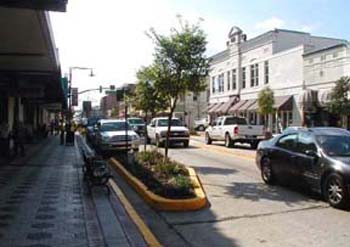 Since becoming preoccupied with bike lanes, I've been thinking a lot about how the way a public space is designed can subtly control how people use the space. With bike lanes, I've been wondering whether the way that New York bike lanes are designed unintentionally invite drivers to park in them.
Since becoming preoccupied with bike lanes, I've been thinking a lot about how the way a public space is designed can subtly control how people use the space. With bike lanes, I've been wondering whether the way that New York bike lanes are designed unintentionally invite drivers to park in them.Dan Lockton, at the Architectures of Control Blog, writes about features designed into city layouts, buildings, and goods that are intended to influence user behavior. He calls these design features 'forcing functions' or 'techniques of persuasion.' Recently he wrote about a counterintuitive article in New Urban News. The article reported that roads planted with trees cause drivers to slow down, and drive with more awareness and caution.
Eric Dumbaugh, an assistant professor of transportation at Texas A&M ... looked at accident records and found that, on the contrary, wide-open corridors encourage motorists to speed, bringing on more crashes. By contrast, tree-lined roadways cause motorists to slow down and drive more carefully, Dumbaugh says.How could New York design roads, sidewalks and bike lanes in ways that similarly influence driver behavior in positive ways? And how can we identity and remedy public spaces that are producing unintended behaviors that run counter to intended uses?
Dumbaugh examined crash statistics and found that tree-lined streets experience fewer accidents than do “forgiving roadsides” — those that have been kept free of large, inflexible objects. He points to “a growing body of evidence suggesting that the inclusion of trees and other streetscape features in the roadside environment may actually reduce crashes and injuries on urban roadways”…
Dan Burden, senior urban designer for Glatting Jackson and Walkable Communities Inc. in Orlando, notes that there is research showing that “motorists need and benefit from tall vertical roadside features such as trees or buildings in order to properly gauge their speed.”
1 comment:
have you seen this site: http://nyc.mybikelane.com/
Post a Comment